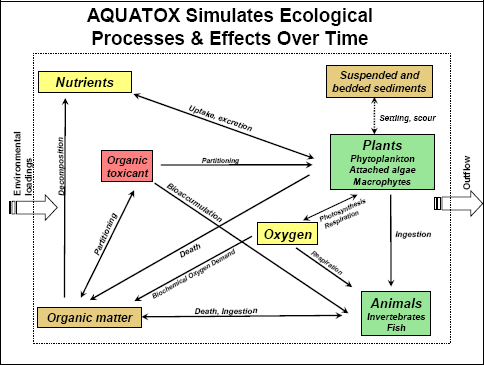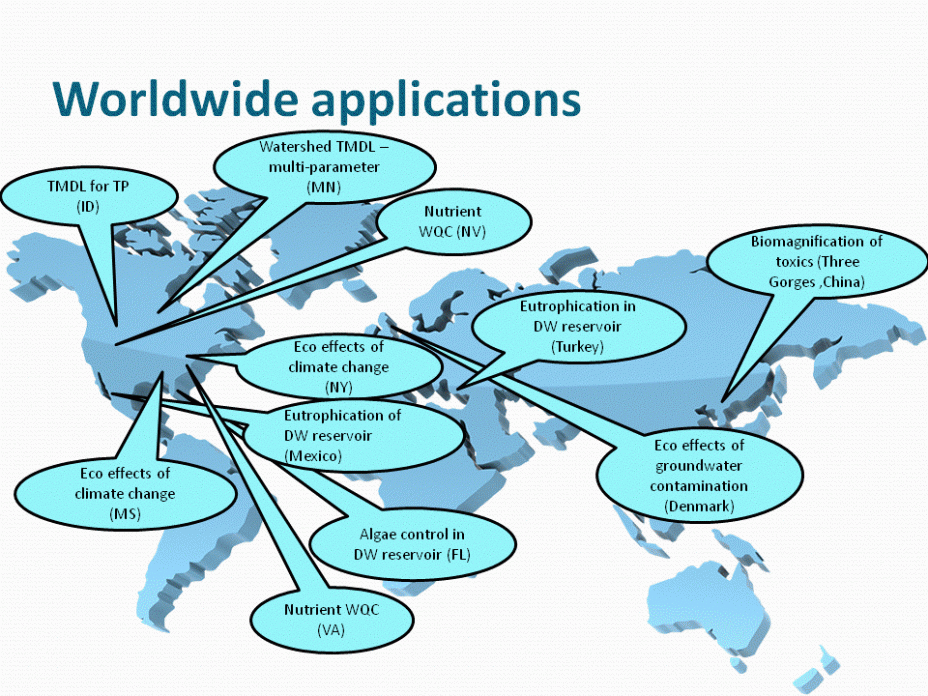AQUATOX Basic Information
AQUATOX is an ecosystem simulation model that predicts the fate of various pollutants, such as excess nutrients and organic chemicals, and their effects on aquatic ecosystems, including fish, invertebrates, and aquatic plants. AQUATOX is a valuable tool for ecologists, biologists, water quality modelers, and anyone who performs ecological risk assessments for aquatic ecosystems. EPA has just released an enhanced version of AQUATOX, Release 3.1, which includes many model interface enhancements and some conceptual model refinements.
Background
One of the biggest challenges to protecting or restoring our nation’s waters is to adequately understand the relationships between the chemical and physical environment and the organisms that live there. Ecosystems are complex, with seasonal and annual variations and multiple interactions among species. The biological communities in many water bodies are impaired, but the causes of the impairment may not be obvious in the face of numerous environmental stressors. It is difficult to predict how the aquatic community will respond to changes in pollutants or environmental conditions with simple methods of analysis, especially if the methods address a single stressor at a time. A complex simulation model may be required.
About AQUATOX
AQUATOX is a PC-based ecosystem model that predicts the fate of nutrients, sediments, and organic chemicals in water bodies, as well as their direct and indirect effects on the resident organisms. AQUATOX simulates the transfer of biomass and chemicals from one compartment of the ecosystem to another. It does this by simultaneously computing important chemical and biological processes over time. AQUATOX simulates multiple environmental stressors (including nutrients, organic loadings, sediments, toxic chemicals, and temperature) and their effects on the algal, macrophyte, invertebrate, and fish communities. AQUATOX can help identify and understand the cause and effect relationships between chemical water quality, the physical environment, and aquatic life. It can represent a variety of aquatic ecosystems, including vertically stratified lakes, reservoirs and ponds, rivers and streams, and estuaries.

AQUATOX Applications
AQUATOX can be used to address a wide variety of issues requiring a better understanding of the processes relating the chemical and physical environment to the biological community. Possible applications of AQUATOX include:
- Developing numeric nutrient targets based on desired biological endpoints.
- Evaluating which of several stressors is causing observed biological impairment.
- Predicting effects of pesticides and other toxic substances on aquatic life.
- Evaluating potential ecosystem responses to climate change.
- Determining effects of land use changes on aquatic life by using the linkage with BASINS.
- Estimating time to recovery of contaminated fish tissues to safe levels after reducing pollutant loads.
AQUATOX has been used all over the world in a wide variety of applications.

About Release 3.1
AQUATOX Release 3.1 and its update contains many enhancements that increase the realism and utility of the model. The most important enhancements include:
- Option to model nutrient limitation in plants based on internal rather than external nutrients, which should improve the prediction of the timing and duration of algal blooms. (new to Release 3.1 update)
- Option of additional ecological metrics such as net primary productivity and fish biomass. (new to Release 3.1 update)
- Sediment diagenesis "steady-state" mode to significantly increase model speed
- Floating plants refinements to allow for additional user control over which algae float and more sophisticated floating behavior in the event of stratification
- PFA-model enhancements that significantly increase model flexibility
- Bioaccumulation updates including linkage to the new EPA ICE toxicity regression models
- Improved sensitivity and uncertainty analysis
- Extensive interface and data-input improvements
